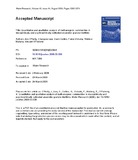JavaScript is disabled for your browser. Some features of this site may not work without it.
| dc.contributor.author | O'Reilly, Joe | |
| dc.contributor.author | Lee, Changsoo | |
| dc.contributor.author | Collins, Gavin | |
| dc.contributor.author | Chinalia, Fabio A. | |
| dc.contributor.author | Mahony, Therese | |
| dc.contributor.author | O'Flaherty, Vincent | |
| dc.date.accessioned | 2009-08-06T10:56:10Z | |
| dc.date.available | 2009-08-06T10:56:10Z | |
| dc.date.issued | 2009-08 | |
| dc.identifier.citation | Joe O'Reilly, Changsoo Lee, Gavin Collins, Fabio Chinalia, Therese Mahony, Vincent O'Flaherty, Quantitative and qualitative analysis of methanogenic communities in mesophilically and psychrophilically cultivated anaerobic granular biofilims, Water Research, Volume 43, Issue 14, August 2009, Pages 3365-3374 | en_UK |
| dc.identifier.issn | 0043-1354 | |
| dc.identifier.uri | http://dx.doi.org/10.1016/j.watres.2009.03.039 | |
| dc.identifier.uri | http://hdl.handle.net/1826/3551 | |
| dc.description.abstract | Anaerobic granulation describes the self-immobilisation of methanogenic consortia into dense, particulate biofilms. This procedure underpins the operation of several categories of high-rate anaerobic wastewater treatment system. Full-scale anaerobic granular sludge plants have been generally operated in the mesophilic (20–45 °C) or thermophilic (45–65 °C) temperature range. On the other hand, recent studies highlighted the economic advantages of treating wastewaters at their discharge temperatures (mostly under 18 °C), removing a costly heating process and increasing net biogas yield. However, as yet, relatively little information is available about the microbial behaviour and interactions in anaerobic granular sludge formed under psychrophilic conditions. To this end, and in order to provide a microbial insight into low-temperature anaerobic granulation, we monitored the changes in methanogenic community structure, associated with the changes in process performance. Three, laboratory-scale, expanded granular sludge bed (EGSB) bioreactors treating a synthetic glucose wastewater were tested at two temperatures of 37 ± 1 °C (R1) and 15 ± 1 °C (R2 and 3). Quantitative real-time PCR and specific methanogenic activity assays highlighted a community shift towards hydrogenotrophic methanogens, particularly the order Methanomicrobiales in the low-temperature bioreactors. Corresponding to this, denaturing gradient gel electrophoresis (DGGE) analysis identified the emergence and maintenance of a Methanocorpusculum-like organism. Our results indicate that hydrogenotrophic methanogens, particularly the Methanomicrobiales-related populations, are likely to play important roles in low-temperature anaerobic granular sludge systems. This suggests that the process efficiency could be improved by facilitating the growth and retention of this group. | en_UK |
| dc.language.iso | en | en_UK |
| dc.publisher | Elsevier | en_UK |
| dc.subject | DGGE | en_UK |
| dc.subject | Low-temperature anaerobic digestion | en_UK |
| dc.subject | Granular biofilm | en_UK |
| dc.subject | Methanogenic community | en_UK |
| dc.subject | Quantitative real-time PCR | en_UK |
| dc.title | Quantitative and qualitative analysis of methanogenic communities in mesophilically and psychrophilically cultivated anaerobic granular biofilims | en_UK |
| dc.type | Article | en_UK |
Files in this item
This item appears in the following Collection(s)
-
Staff publications (SAS) [907]
